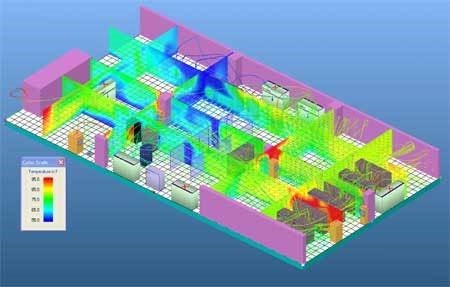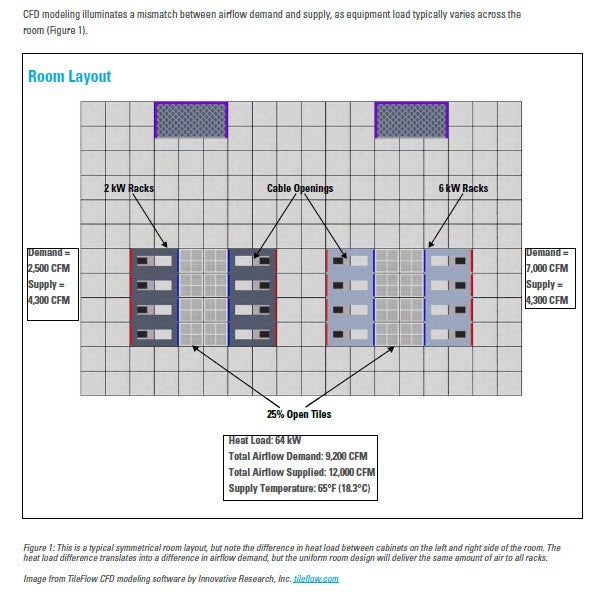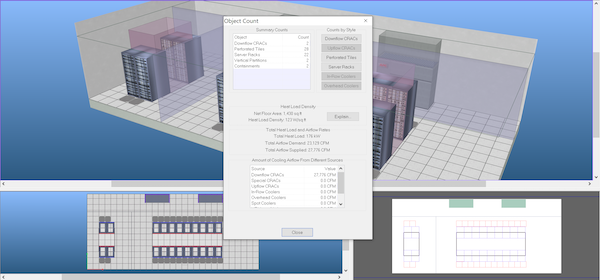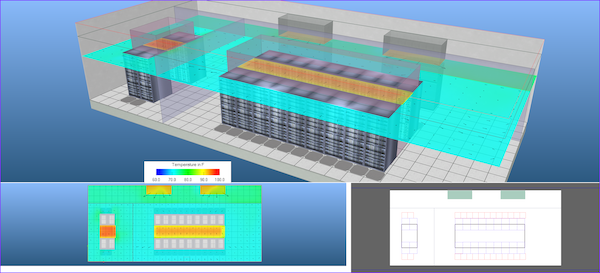
Efficient airflow management is not just about separating hot and cold air—it’s about making data-driven decisions to maximize efficiency, reduce costs, and avoid costly mistakes.
Even with general airflow management in place, complex data center environments often experience hidden cooling inefficiencies. These issues might include uneven temperature distribution, localized hotspots, or inefficient use of cooling equipment.
Identifying the root causes of these problems is the first step toward implementing a sustainable solution—and this is where Computational Fluid Dynamics (CFD) analysis comes into play.
What is Computational Fluid Dynamics (CFD) Modeling?
You can think of airflow like water—it flows, swirls, and encounters resistance in much the same way. CFD analysis acts like a virtual current map, using advanced numerical modeling to create a detailed representation of your environment. It lets you see how air "flows" through your data center, spot bottlenecks and turbulence, and understand temperature and pressure patterns with remarkable precision
As one of our CFD experts with over 15 years of experience, says, “Everyone has opinions—hot aisles, cold aisles—but CFD provides the hard data that shows the best design for your specific setup.”
Look at the examples of CFD modeling in Figures 1 and 2 below:


How CFD Modeling Solves Cooling Challenges
You might ask, “Can’t you just feel the temperature variations in the room?” Sure, but large, complex data centers often have hidden inefficiencies that even seasoned professionals can’t identify or solve.
CFD modeling makes the invisible visible, answering critical questions like:
- Are unsealed openings in raised floor tiles causing airflow inefficiencies?
- Would rearranging equipment improve airflow, or is installing containment the better option?
- Which containment method—aisle-level or cabinet-level—provides the best results for this setup?
And here’s the best part: you can see the results virtually before making any physical changes, saving time and money.


Real-World Success Stories
Chatsworth Products (CPI) has helped countless data centers optimize their operations with CFD analysis, avoiding costly mistakes and ensuring efficient designs. Here are some examples:
- Avoiding Costly Mistakes: In a 300-cabinet data center, high-density cabinets were placed near perimeter cooling units, assuming proximity would improve cooling. Our CFD analysis showed that airflow bypassed the tiles near the cabinets, causing inefficiencies. By balancing airflow and pressures, we redesigned the setup to prevent significant cooling issues—saving the customer time, money, and future headaches.
- Validating Designs: A global IT company turned to CPI for CFD analysis to validate the design of their new data center. With our modeling, we ensured that the layout and cooling strategy would deliver optimal performance from Day One—avoiding any unexpected inefficiencies after deployment.
- Handling Complex Setups: A healthcare provider operating a massive 1,100-cabinet deployment with 45 cooling units faced persistent heat issues. CPI’s CFD analysis pinpointed the root causes of the problem. With our recommendations, they restored thermal balance and regained control of their environment, eliminating unnecessary energy costs.
- Optimizing Existing Infrastructure: Our CFD analysis works in any environment. For one customer with cabinets from another vendor, our analysis identified inefficiencies caused by leaks, porous tops, and misaligned airflow paths. With tailored recommendations, we significantly improved their cooling efficiency—without requiring a full overhaul of their existing setup.
Benefits of CFD Modeling with Chatsworth Products
At Chatsworth Products (CPI), we offer FREE CFD analysis with a powerful tool known as “TileFlow” to help customers design more efficient data centers.
Our team of data center design consultants, field application engineers, and technical support experts brings decades of proven expertise in airflow management and containment solutions. We’ve tackled and solved nearly every airflow challenge.
From government agencies to Fortune 500 companies, our CFD analysis has helped optimize countless data centers. In fact, over 90% of customers who use CPI’s CFD analysis move forward with projects, confident in the actionable insights we provide
How our CFD service works:
- Comprehensive Assessment: We evaluate your data center’s layout, including size, floor/ceiling heights, CRAC locations, and existing airflow measures.
- Analysis & Recommendations: Our CFD software simulates airflow to identify inefficiencies and provide actionable solutions, like better equipment placement and optimized containment.
- Visual Comparisons: See before-and-after visuals to understand the impact of proposed changes before implementation.
To learn more about how CPI's CFD services and support team can work for you, watch the video below and
Ready to Optimize Your Data Center Cooling?
Whether you’re avoiding a "Day One" disaster or validating a cutting-edge design, CPI’s CFD analysis gives you the confidence to move forward.
and our global team—including experts in South America, China, and the Middle East—will reach out to guide you through the process.

